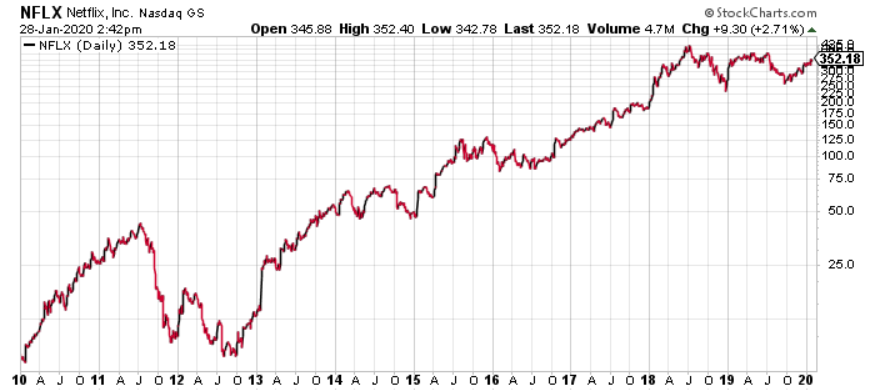These Tech Stocks Have Made Millions for Investors; More to Come?
Marijuana Business, Stocks, Finance, & Investing January 31, 2020 MJ Shareholders 0

 Looking to Profit From Tech Stocks? Read This
Looking to Profit From Tech Stocks? Read This
If you want to make oversized profits in today’s stock market, tech is probably the best place to look. Over the years, we have seen many tech stocks shoot through the roof, making their shareholders rich during the process.
But those astronomical gains are not always easy to pocket. Very often, they involve betting on a small tech company that’s yet to make it to the main stage.
As we’ve seen plenty of times, in the fast-changing tech world, not every company can maintain its relevance; even the high-profile initial public offerings (IPOs) may turn out to be flops.
In other words, while tech stocks have the potential to deliver outsized returns, they also tend to be riskier than boring industries like utilities or consumer staples.
However, that doesn’t mean risk-averse investors should ignore the tech sector. For instance, there is one industry that’s already quite established but still has serious growth potential: video streaming.
This Booming Industry Has Already Made Investors Rich
A lot of people (myself included) grew up watching cable or satellite TV. Fighting over the remote was a daily event in many households.
But now, things have changed. Gone are the days when the whole family would sit in front of one television. Instead, you’ll often find each family member in their own room, streaming their favorite shows on a tablet, computer, or mobile phone.
In fact, there is a word that describes this transition: cord-cutting. In the United States, households have been dropping pay-TV subscriptions and signing up for video streaming services delivered via the Internet.
The reason is two-fold. First, the traditional TV channel bundles are expensive compared to what a streaming service typically costs. Second, viewers can watch whatever they want, when they want, and where they want on a streaming service, rather than having to wait for their favorite program to air at a specific time on cable or satellite TV.
Cord-cutting has been going on for a while, and it’s yet to show signs of slowing down.
In the third quarter of 2019, America’s largest pay-TV providers lost 1.7 million net video subscribers. (Source: “Major Pay-TV Providers Lost About 1,740,000 Subscribers in 3Q 2019,” Leichtman Research Group, Inc., November 13, 2019.)
This was a much bigger loss compared to their pro forma net loss of around 975,000 subscribers in the third quarter of 2018.
It doesn’t help that the Internet is getting faster and more households are connected to it than ever before.
A recent study found that, in the U.S., 85% of households now have Internet service at home, compared to 80% in 2009. Moreover, among the households with home Internet, broadband accounts for 96%. (Source: “85% of U.S. Households Get an Internet Service at Home,” Leichtman Research Group, Inc., December 23, 2019.)
What this means is that more people than ever have the option of switching from pay-TV to a video streaming service.
If you are an investor in cable companies, the cord-cutting trend would seem quite scary. If you bought shares of video streaming companies, on the other hand, you could be laughing all the way to the bank.
Speaking of video streaming stocks, Netflix Inc (NASDAQ:NFLX) is probably the first one to come to mind. The company started out as a DVD rental by mail business in 1997. In 2007, it introduced video on demand via the Internet, and the rest is history.
To investors, Netflix is known for its astonishing stock-price performance. Consider that, on its first trading day of 2010, NFLX stock opened at $7.93 per share. On its last trading day of 2019, it closed at $323.57 per share. That’s a return of 3,980% over the decade!
That means, if an investor had bought $24,500 worth of Netflix stock at the beginning of 2010, their position would have been worth about $1.0 million at the end of 2019.
The momentum in this video streaming stock is still continuing, as the below chart shows.
Netflix Inc (NASDAQ:NFLX) Stock Chart
Chart courtesy of StockCharts.com
The reality is, on-demand video streaming is an industry that’s firing on all cylinders, and Netflix has been well positioned to ride the wave right from the start.
In just the fourth quarter of 2019, the company’s streaming service added 8.8 million paying members. Today, Netflix has more than 167 million paying subscribers around the world. (Source: “Letter to Shareholders,” Netflix Inc, January 21, 2020.)
In many exciting new industries, companies are focusing on top-line growth rather than profitability. It’s common to see a hot tech company with impressive sales growth still lose money quarter after quarter.
But as I said earlier, on-demand video streaming is no longer a nascent industry. And that means companies can actually turn a profit, which is what risk-averse investors want to see.
In the case of Netflix, the company earned a net income of $587.0 million in the fourth quarter of 2019.
While turning a profit at the bottom line, Netflix’s top-line growth remained pretty impressive. In the fourth quarter, the company generated $5.5 billion of revenue, representing a 30.6% increase year-over-year.
For investors who were looking for video streaming stocks, Netflix was the most popular option. And as consumers kept migrating from traditional pay-TV to Internet streaming, Netflix’s business boomed and its investors were rewarded big-time.
And the best could be yet to come.
In the first quarter of 2020, Netflix expects to add another seven million paying subscribers worldwide, bringing its total paid membership base to 174.1 million.
The company also expects to generate $5.7 billion of revenue for the quarter, which would mark a 27% increase year-over-year.
A New Era for Video Streaming Stocks
So, that means Netflix is the best video streaming stock, right?
Well, in my opinion, the best part about the industry is that we probably won’t see a “one player wins all the prizes” scenario. Instead of one company dominating forever, what’s likely going to happen is multiple streaming service providers co-existing and growing their businesses at the same time.
In fact, it’s already happening. Hulu, another streaming service provider, has long lived in the shadow of Netflix. But the company has still managed to grow its business.
At the beginning of 2019, Hulu was adding twice as many subscribers in the U.S. as Netflix was. (Source: “Hulu gained twice as many US subscribers as Netflix at the start of 2019,” CNBC, May 1, 2019.)
Hulu has been in the streaming business for over a decade and already has an established market position. But it’s still possible for a company that’s quite late to the game to get a piece of the action.
Just take a look at Disney+ and you’ll see what I mean. Disney+ is the on-demand video streaming service from Walt Disney Co (NYSE:DIS).
When Disney+ was launched in November 2019, it instantly turned into a huge hit. Within 24 hours, the service received more than 10 million signups. (Source: “Disney+ surpasses 10 million sign-ups since launch,” CNBC, November 13, 2019.)
Later on, it was estimated that Disney+ was adding almost one million customers per day. (Source: “Disney+ is adding nearly a million new subscribers a day, according to research firm,” MarketWatch, November 26, 2019.)
Now, I should point out that Walt Disney Co was already in the streaming business prior to the launch of Disney+. The company has a controlling stake in Hulu, and it has also been providing ESPN+, another video streaming service, for more than a year.
However, due to the fact that Walt Disney Co also operates multiple cable TV networks, video streaming was often considered a headwind for the company. But because of the success of Disney+, DIS stock has been getting some renewed investor attention.
A streaming service provider doesn’t necessarily have to come from the media industry. Amazon.com, Inc.’s (NASDAQ:AMZN) “Amazon Prime Video” is a video streaming service that started out as a perk for “Amazon Prime” members.
Over the years, Amazon Prime Video has grown into a huge operation. In April 2019, it was reported that Amazon could spend as much as $7.0 billion on video and music content that year. (Source: “Amazon on Pace to Spend $7 Billion on Video and Music Content This Year, According to New Disclosure,” CNBC, April 26, 2019.)
AMZN also happens to be a soaring ticker. Over the past five years, Amazon’s share price has increased by more than 420%.
Amazon.com, Inc. (NASDAQ:AMZN) Stock Chart
Chart courtesy of StockCharts.com
Of course, Amazon is mainly an e-commerce company. And its surging stock price was largely due to its booming e-commerce business. Nonetheless, the company is one of the big players in the video streaming industry.
Most of today’s video streaming services are not expensive. Disney+ costs $6.99 a month (or $69.99 annually), Hulu Basic costs $5.99 a month, and Hulu Premium costs $11.99 a month.
With Netflix, the most popular plan costs $12.99 a month. Amazon Prime costs $12.99 a month (or $119.00 annually) , and it gives members a bunch of perks other than video streaming.
Analyst Take
Netflix, Hulu, Amazon Prime, and Disney+ are just some of the available video streaming services.
Because none of these video streaming services are prohibitively expensive or require long-term commitments, a consumer who likes a particular show from a particular provider can try out the service at a low cost. Then they might discover other shows that they like from that provider and keep using the service.
That is, instead of choosing between two streaming services, it’s quite affordable to have both (especially compared to traditional cable TV). That means, even if a new player enters the streaming industry with a large content library, it’s not going to be end of the world for the existing companies.
And that’s why, for investors looking for fast-growing tech stocks, video streaming companies could be a relatively safe option.
MJ Shareholders
MJShareholders.com is the largest dedicated financial network and leading corporate communications firm serving the legal cannabis industry. Our network aims to connect public marijuana companies with these focused cannabis audiences across the US and Canada that are critical for growth: Short and long term cannabis investors Active funding sources Mainstream media Business leaders Cannabis consumers











No comments so far.
Be first to leave comment below.